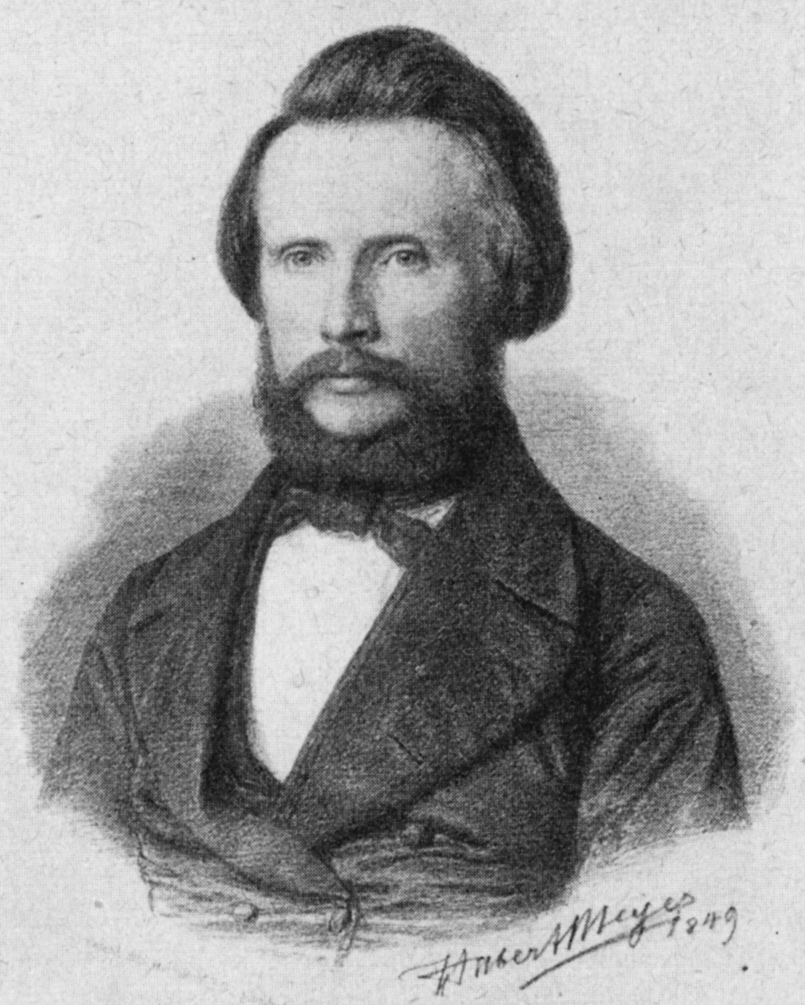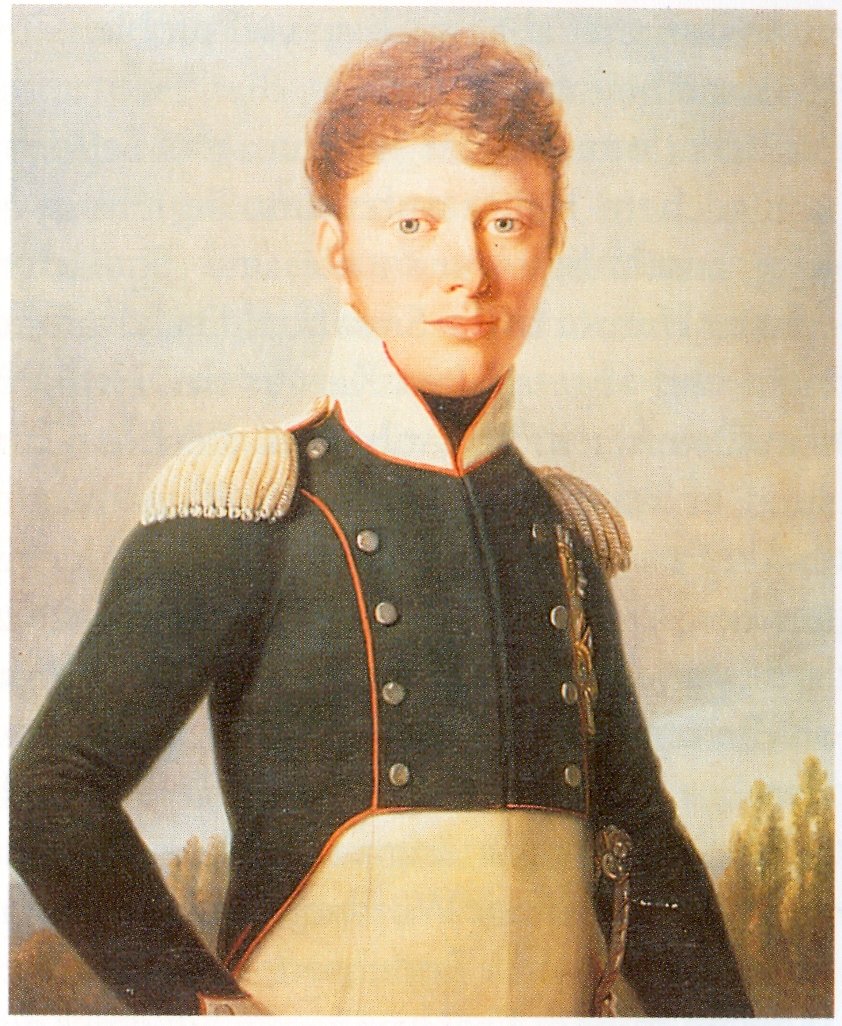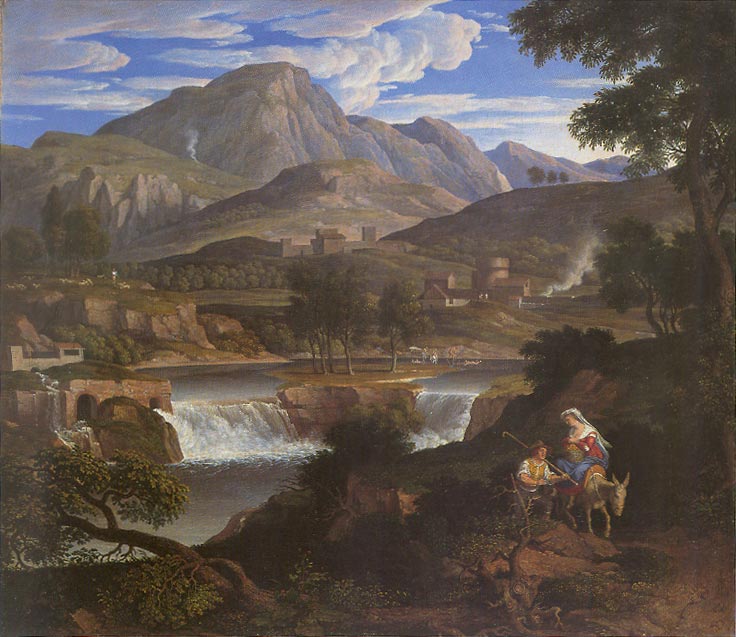|
Friedrich Mosbrugger
Friedrich Mosbrugger, also known as Fritz Moosbrugger (19 September 1804, in Konstanz – 17 October 1830, in Saint Petersburg) was a German portrait and genre painter in the Realistic style. He came from a family that had a widespread reputation as builders, plasterers and painters.*, included in the article on his father, Wendelin. His brother Joseph was also a painter, and his brother was an architect. Life His father was Wendelin Moosbrugger, a Court Painter for Frederick I of Württemberg. He received his first lessons from his father and another painter from Konstanz, Marie Ellenrieder, then studied at the Academy of Fine Arts, Munich, with Johann Peter von Langer After displaying some paintings at an exhibition in Karlsruhe in 1827, he followed his friend, the architect Friedrich Eisenlohr, to Italy and became a part of the German circle of artists resident in Rome. While there, he sought the opinions and advice of Joseph Anton Koch regarding his work. In the summ ... [...More Info...] [...Related Items...] OR: [Wikipedia] [Google] [Baidu] |
Mosbrugger - Selbst
Friedrich Mosbrugger, also known as Fritz Moosbrugger (19 September 1804, in Konstanz – 17 October 1830, in Saint Petersburg) was a German portrait and Genre art, genre painter in the Realism (art), Realistic style. He came from a family that had a widespread reputation as builders, plasterers and painters.*, included in the article on his father, Wendelin. His brother Joseph Moosbrugger, Joseph was also a painter, and his brother was an architect. Life His father was Wendelin Moosbrugger, a Court painter, Court Painter for Frederick I of Württemberg. He received his first lessons from his father and another painter from Konstanz, Marie Ellenrieder, then studied at the Academy of Fine Arts, Munich, with Johann Peter von Langer After displaying some paintings at an exhibition in Karlsruhe in 1827, he followed his friend, the architect Friedrich Eisenlohr, to Italy and became a part of the German circle of artists resident in Rome. While there, he sought the opinions and ad ... [...More Info...] [...Related Items...] OR: [Wikipedia] [Google] [Baidu] |
Friedrich Eisenlohr
Jakob Friedrich Eisenlohr (23 November 1805, Lörrach - 27 February 1854, Karlsruhe) was a German architect and university professor. His design for a cuckoo clock, now known as the Cuckoo clock#Bahnhäusle style, a successful design from Furtwangen, Bahnhäusle (train station) style, was the first to be mass-produced and helped make the clocks popular outside of Germany. Life and work His father, Jakob Friedrich Eisenlohr (1777–1854), was an evangelical pastor. From 1821 to 1824, he studied in Freiburg im Breisgau with the architect, .Peter Pretsch: "Friedrich Eisenlohr. Architekt der badischen Eisenbahn", In: ''Blick in die Geschichte'', Nr. 67, 24 June 2005Online After that, he moved to Karlsruhe, where he studied at the building school operated by Friedrich Weinbrenner. From 1826 to 1828, he continued his studies in Italy. After serving an apprenticeship, he became a teacher at the Polytechnischen Oberschule in Karlsruhe where, in 1839, he became a building official, and ... [...More Info...] [...Related Items...] OR: [Wikipedia] [Google] [Baidu] |
German Genre Painters
German(s) may refer to: * Germany (of or related to) ** Germania (historical use) * Germans, citizens of Germany, people of German ancestry, or native speakers of the German language ** For citizens of Germany, see also German nationality law **Germanic peoples (Roman times) * German language **any of the Germanic languages * German cuisine, traditional foods of Germany People * German (given name) * German (surname) * Germán, a Spanish name Places * German (parish), Isle of Man * German, Albania, or Gërmej * German, Bulgaria * German, Iran * German, North Macedonia * German, New York, U.S. * Agios Germanos, Greece Other uses * German (mythology), a South Slavic mythological being * Germans (band), a Canadian rock band * "German" (song), a 2019 song by No Money Enterprise * ''The German'', a 2008 short film * "The Germans", an episode of ''Fawlty Towers'' * ''The German'', a nickname for Congolese rebel André Kisase Ngandu See also * Germanic (other) * ... [...More Info...] [...Related Items...] OR: [Wikipedia] [Google] [Baidu] |
German Male Painters
German(s) may refer to: * Germany (of or related to) **Germania (historical use) * Germans, citizens of Germany, people of German ancestry, or native speakers of the German language ** For citizens of Germany, see also German nationality law **Germanic peoples (Roman times) * German language **any of the Germanic languages * German cuisine, traditional foods of Germany People * German (given name) * German (surname) * Germán, a Spanish name Places * German (parish), Isle of Man * German, Albania, or Gërmej * German, Bulgaria * German, Iran * German, North Macedonia * German, New York, U.S. * Agios Germanos, Greece Other uses * German (mythology), a South Slavic mythological being * Germans (band), a Canadian rock band * "German" (song), a 2019 song by No Money Enterprise * ''The German'', a 2008 short film * "The Germans", an episode of ''Fawlty Towers'' * ''The German'', a nickname for Congolese rebel André Kisase Ngandu See also * Germanic (other) * Germa ... [...More Info...] [...Related Items...] OR: [Wikipedia] [Google] [Baidu] |
1830 Deaths
Year 183 ( CLXXXIII) was a common year starting on Tuesday (link will display the full calendar) of the Julian calendar. At the time, it was known as the Year of the Consulship of Aurelius and Victorinus (or, less frequently, year 936 ''Ab urbe condita''). The denomination 183 for this year has been used since the early medieval period, when the Anno Domini calendar era became the prevalent method in Europe for naming years. Events By place Roman Empire * An assassination attempt on Emperor Commodus by members of the Senate fails. Births * January 26 – Lady Zhen, wife of the Cao Wei state Emperor Cao Pi (d. 221) * Hu Zong, Chinese general, official and poet of the Eastern Wu state (d. 242) * Liu Zan (Zhengming), Chinese general of the Eastern Wu state (d. 255) * Lu Xun Zhou Shuren (25 September 1881 – 19 October 1936), better known by his pen name Lu Xun (or Lu Sun; ; Wade–Giles: Lu Hsün), was a Chinese writer, essayist, poet, and literary critic. He ... [...More Info...] [...Related Items...] OR: [Wikipedia] [Google] [Baidu] |
1804 Births
Eighteen or 18 may refer to: * 18 (number), the natural number following 17 and preceding 19 * one of the years 18 BC, AD 18, 1918, 2018 Film, television and entertainment * ''18'' (film), a 1993 Taiwanese experimental film based on the short story ''God's Dice'' * ''Eighteen'' (film), a 2005 Canadian dramatic feature film * 18 (British Board of Film Classification), a film rating in the United Kingdom, also used in Ireland by the Irish Film Classification Office * 18 (''Dragon Ball''), a character in the ''Dragon Ball'' franchise * "Eighteen", a 2006 episode of the animated television series ''12 oz. Mouse'' Music Albums * ''18'' (Moby album), 2002 * ''18'' (Nana Kitade album), 2005 * '' 18...'', 2009 debut album by G.E.M. Songs * "18" (5 Seconds of Summer song), from their 2014 eponymous debut album * "18" (One Direction song), from their 2014 studio album ''Four'' * "18", by Anarbor from their 2013 studio album '' Burnout'' * "I'm Eighteen", by Alice Cooper common ... [...More Info...] [...Related Items...] OR: [Wikipedia] [Google] [Baidu] |
Paul Emil Jacobs
Paul Emil Jacobs (August 20, 1802 in Gotha – January 6, 1866) was a German painter, noted for Orientalist themes, portraits and nudes. Life and career Jacobs, son of the philologist Frederick Jacobs, received his art training at the Munich Academy of Fine Arts and first became known for his painting of Mercury and Argus (from Classical mythology). In 1824 he went to Rome, where he attracted critical attention by painting "The Raising of Lazarus". In 1836 he made a series of historical paintings at the Welfenschloss in Hannover. Jacobs was noted for his mastery of nudes, expressed particularly in the representation of such Orientalist themes as "A slave market" or of sleeping and waking naked boys. Graceful depictions of the female body include his ''"A Harem Beauty At Her Toilette"'' and ''"Zither-playing Turk"''. His image of Scheherezade from ''Arabian Nights'' is noted for its light effects. The famous Ali Pasha was depicted by Jacobs in a moment of relaxed in ... [...More Info...] [...Related Items...] OR: [Wikipedia] [Google] [Baidu] |
Lübeck
Lübeck (; Low German also ), officially the Hanseatic City of Lübeck (german: Hansestadt Lübeck), is a city in Northern Germany. With around 217,000 inhabitants, Lübeck is the second-largest city on the German Baltic coast and in the state of Schleswig-Holstein, after its capital of Kiel, and is the 35th-largest city in Germany. The city lies in Holstein, northeast of Hamburg, on the mouth of the River Trave, which flows into the Bay of Lübeck in the borough of Travemünde, and on the Trave's tributary Wakenitz. The city is part of the Hamburg Metropolitan Region, and is the southwesternmost city on the Baltic, as well as the closest point of access to the Baltic from Hamburg. The port of Lübeck is the second-largest German Baltic port after the port of Rostock. The city lies in the Northern Low Saxon dialect area of Low German. Lübeck is famous for having been the cradle and the ''de facto'' capital of the Hanseatic League. Its city centre is Germany's most extens ... [...More Info...] [...Related Items...] OR: [Wikipedia] [Google] [Baidu] |
William I Of Württemberg
William I (german: Friedrich Wilhelm Karl; 27 September 178125 June 1864) was King of Württemberg from 30 October 1816 until his death. Upon William's accession, Württemberg was suffering crop failures and famine in the "Year Without a Summer", in 1816. After taking office, he initiated sweeping reforms, resulting in the approval of the Estates of Württemberg to a constitution on 25 September 1819. In his 48-year reign, the kingdom moved from one that was created from different denominational principalities and a heterogeneous agricultural country, into a constitutional state with a common identity and a well-organised management. In addition to his successful domestic policy, he pursued throughout his reign an ambition focused on German and European foreign policy. Alongside the great powers of Prussia and Austria, he imagined a third major German power in the form of Bavaria, Saxony, Hanover and Württemberg. Although this plan never succeeded, it ensured a consistent, coheren ... [...More Info...] [...Related Items...] OR: [Wikipedia] [Google] [Baidu] |
Nicholas I Of Russia
Nicholas I , group=pron ( – ) was List of Russian rulers, Emperor of Russia, Congress Poland, King of Congress Poland and Grand Duke of Finland. He was the third son of Paul I of Russia, Paul I and younger brother of his predecessor, Alexander I of Russia, Alexander I. Nicholas inherited his brother's throne despite the failed Decembrist revolt against him. He is mainly remembered in history as a reactionary whose controversial reign was marked by geographical expansion, economic growth, and massive industrialisation on the one hand, and centralisation of administrative policies and repression of dissent on the other. Nicholas had a happy marriage that produced a large family; all of their seven children survived childhood. Nicholas's biographer Nicholas V. Riasanovsky said that he displayed determination, singleness of purpose, and an iron will, along with a powerful sense of duty and a dedication to very hard work. He saw himself as a soldier—a junior officer totally consumed ... [...More Info...] [...Related Items...] OR: [Wikipedia] [Google] [Baidu] |
Sabine Hills
Sabina (Latin: ''Sabinum''), also called the Sabine Hills, is a region in central Italy. It is named after Sabina, the territory of the ancient Sabines, which was once bordered by Latium to the south, Picenum to the east, ancient Umbria to the north and Etruria to the west. It was separated from Umbria by the River Nar, today's Nera, and from Etruria by the River Tiber. Today, Sabina is mainly northeast of Rome in the regions Lazio, Umbria and Abruzzo. ''Upper Sabina'' is in the province of Rieti (Poggio Mirteto, Magliano Sabina, Casperia, Montopoli di Sabina, Torri in Sabina, Cantalupo in Sabina, Montebuono, Forano, Poggio Catino, Montasola, Stimigliano, Castelnuovo di Farfa, Fara in Sabina, Roccantica, Mompeo, Salisano, Cottanello, Configni, Vacone, Tarano, Collevecchio, Toffia, Poggio Nativo, Scandriglia ecc.). ''Sabina Romana'' is in the province of Rome (Mentana, Monteflavio, Montelibretti, Monterotondo, Montorio Romano, Moricone, Nerola, Palombara Sabina). Part of Sab ... [...More Info...] [...Related Items...] OR: [Wikipedia] [Google] [Baidu] |
Joseph Anton Koch
Joseph Anton Koch (27 July 1768 – 12 January 1839) was an Austrian painter of Neoclassicism and later the German Romantic movement; he is perhaps the most significant neoclassical landscape painter. Biography The Tyrolese painter was born in Elbigenalp. Early in his life he was tending cattle. Through the recommendation of Bishop Umgelder (1785), he received academic training in the Karlsschule Stuttgart, a strict military academy. In 1791, he ran away, and traveled through France and Switzerland. He arrived in Rome in 1795. Koch was close to the painter Asmus Jacob Carstens and carried on Carstens' "heroic" art, at first in a literal manner. He etched the pages of Carstens' ''Les Argonautes, selon Pindar, Orphée et Apollonius de Rhode'' (Rome, 1799). After 1800, Koch developed as a landscape painter. In Rome, he espoused a new type of "heroic" landscape, revising the classical compositions of Poussin and Lorrain with a more rugged, mountainous scenery. In 1812, force ... [...More Info...] [...Related Items...] OR: [Wikipedia] [Google] [Baidu] |







